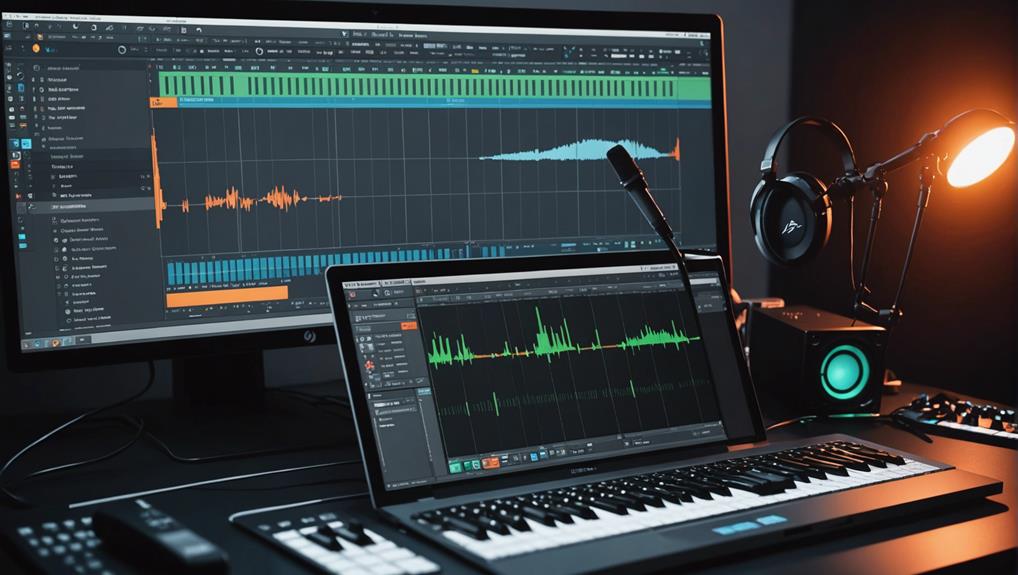To create memorable melodies in FL Studio, start by choosing your scale—go for major for a happy vibe or minor for something more emotional. Next, build your chord progression using a simple structure like I-IV-V, and feel free to transpose for variety. Finally, amplify your melody’s appeal by adding rhythmic variations and layering harmonies; this keeps it engaging and dynamic. Remember to play with instrumentation to add texture as your piece evolves. Master these steps, and your melodies will shine—they’re only the beginning of your musical journey, inviting you to explore further opportunities.
Key Takeaways
- Start by selecting a scale, either major or minor, to set the foundational mood for your melody.
- Create a simple chord progression using common patterns like I-IV-V to support your melody.
- Experiment with rhythmic variations and non-chord tones to add interest and tension to your melody.
- Layer harmonies or counter melodies that align with your chosen scale for a richer sound.
- Use FL Studio’s mixing tools to refine your melody, adjusting levels and adding effects for clarity and depth.
Choose Your Scale
When you immerse yourself in melody creation, choosing the right scale sets the foundation for your musical journey. The first thing you should do is make sure you select either a major or minor scale. Major scales bring uplifting vibes, while minor scales delve into darker tones.
Familiarize yourself with the corresponding minor scale; for instance, C major pairs with A minor. A scale chart can be your best friend here, helping visualize notes and their relationships.
Don’t hesitate to experiment with different scales, as they offer a variety of emotional expressions. Remember, each scale has its own unique set of chords waiting to enhance your melodic ideas and add depth, even in those lower frequencies. Utilizing different modes like Dorian can further expand your melodic palette and evoke distinct atmospheres.
Build Chord Progressions
With your chosen scale in hand, it’s time to build chord progressions that breathe life into your melodies. Start by selecting a root note, like C, and craft a progression using major and minor chords for emotional depth.
Experiment with the following techniques to make it sound pretty good:
- Use common progressions like I-IV-V (C-F-G) for a solid foundation.
- Transpose chords up or down five notes for a variety of different sounds.
- Keep your structures simple to enhance layering in the low end.
Additionally, understanding the emotional impact of minor scales can enhance the depth of your chord progressions and melodies. These strategies won’t only enhance your chord progression but also provide a rich canvas for additional melodies and harmonies. Immerse yourself and let your creativity flow!
Add Melodic Variations
To keep your melody enchanting, incorporate variations that boost its dynamism and emotional resonance. Try introducing melodic variations through rhythmic alterations every two bars; this keeps the listener engaged.
Use non-chord tones like passing and neighbor tones to inject tension while adhering to your scale. Duplicate your main melody, modify a few notes or rhythms, and create cohesive yet distinct sections within your composition.
Layer harmonies by adding counter melodies that complement the primary theme, ensuring they share notes from the same scale.
Finally, consider varying instrumentation or sound texture in the latter half of your melody. This contrast not only maintains interest but also enhances your composition, engaging your audience throughout. Additionally, applying surgical EQ cuts can help remove any resonant frequencies that may clash with your melodic variations.
Frequently Asked Questions
How to Make a Simple Melody in FL Studio?
To craft a simple melody, start with melody creation tips like selecting a scale. Use the piano roll for basic melody structure, apply chord progression basics, and explore melody variation techniques with composition tools. Enjoy the process!
What Are the Steps in Creating a Simple Melody?
To create a melody, start with melody structure and note progression, explore chord variations, develop rhythm patterns, and employ melodic motifs. Use creative techniques to innovate and enhance your composition, keeping it engaging and dynamic.
How to Write a Melody for Beginners?
To write a melody, start with scale selection and establish your melody structure. Experiment with note progression, rhythmic patterns, and chord combinations. Incorporate melodic motifs for interest, ensuring your composition flows beautifully while engaging listeners.
How to Make Synth Melodies in FL Studio?
To craft enchanting synth melodies, focus on sound selection strategies and chord progression basics. Experiment with rhythm variation tips, practice melodic improvisation exercises, and apply melody layering techniques for a rich, dynamic soundscape that stands out.
Conclusion
Now that you’ve chosen your scale, built your chord progressions, and added those melodic variations, you’re ready to release your creativity in FL Studio. Remember, experimentation is key—don’t shy away from tweaking notes or layering sounds. Each melody you craft is a step toward mastering your unique sound. So immerse yourself, trust your instincts, and let the music flow. With practice, those simple steps will evolve into your signature style. Happy producing!



